The Sandhills region is tops for Blanding’s turtle habitat and numbers
Enlarge
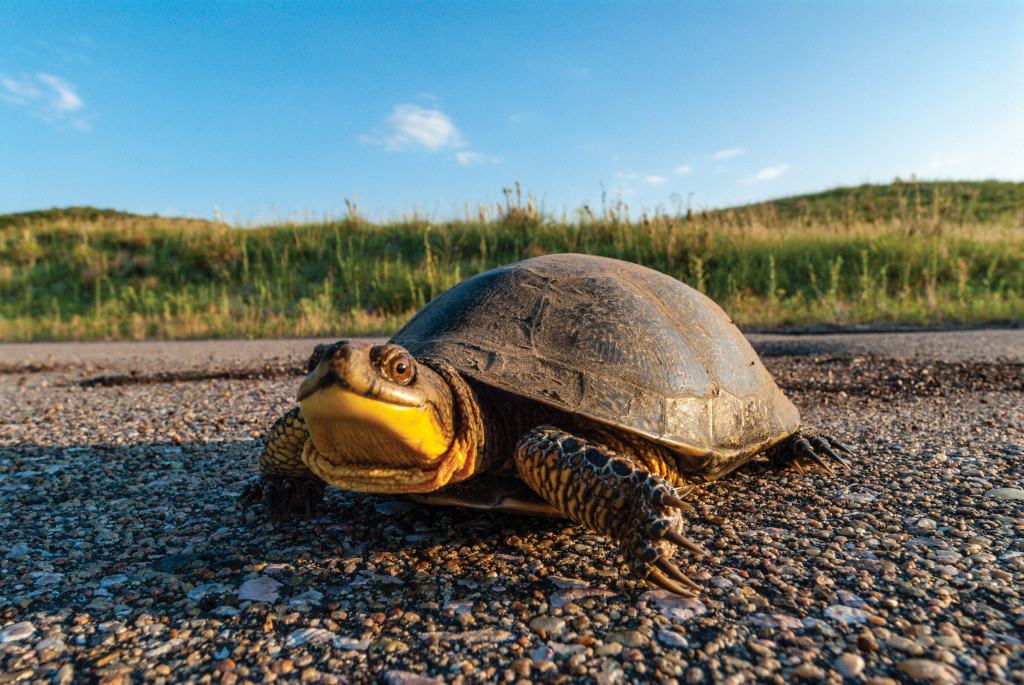
has helped the species survive there better than more populated regions of the continent.
Story and photos by Justin Haag
Grass-covered sand dunes accented by wetland marshes and lakes as far as the eye can see. Humans and vehicle traffic sparse. Vibrant community of turtles and other wildlife.
If real estate advertisements targeted wildlife, such words would catch the eye of at least one species. Thanks to research at the Valentine National Wildlife Refuge, we know many Blanding’s turtles (Emydoidea blandingii) are already living the good life in the Nebraska Sandhills — so much so that the region is increasingly becoming known as Blanding’s turtle capital of the world.
Meet the Blanding’s Turtle
Ask a naturalist to describe the Blanding’s turtle, and chances are you will be told it appears to be smiling. Its dark head with highly contrasting yellow chin makes it look that way, and serves as its most significant identifier.
Its high-domed dark shell is usually accented with dots and short streaks of yellow. The plastron, the bottom portion of the shell, is hinged like that of a box turtle but does not close as tightly. The turtle is mostly carnivorous, eating creatures such as snails, insects, tadpoles, crawdads and frogs. It was named for the first person believed to have described it, Dr. William Blanding, an East Coast physician and naturalist who lived 1773-1857.
A semi-aquatic species that loves marshy areas, the turtle’s historical range is centered in Michigan and includes portions of states and provinces that border the Great Lakes. The range also extends into parts of the East Coast, Missouri and, of course, Nebraska.
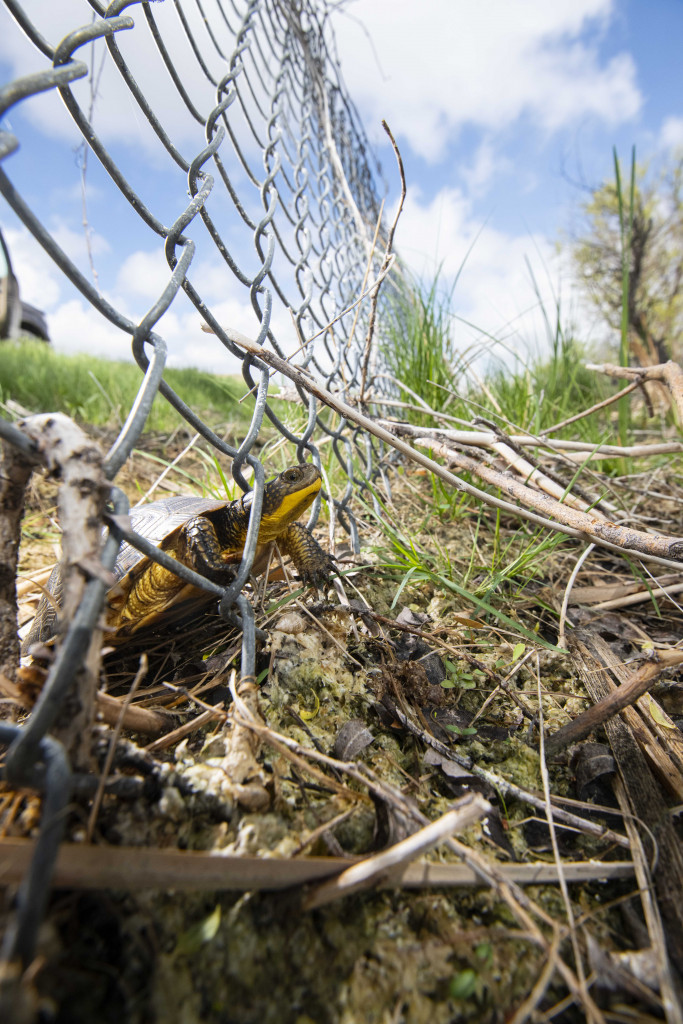
It is a sizable range, but the turtle’s distribution is spotty. Most populations are small, numbering in the tens, rather than hundreds. Nebraska is the only state in which the species is “apparently secure,” a favorable ranking on NatureServe, the national nonprofit that combines species data from state and federal sources. In all other states and provinces, rankings range from “vulnerable” to “critically imperiled.”
The Blanding’s turtle is listed as a “tier 1” species in the Natural Legacy Project, Nebraska’s wildlife action plan. That makes it Nebraska’s only turtle species designated to have the greatest need of conservation.
The species is doing well in the Sandhills, but likely has suffered in other parts of the state. While populations of many wildlife species may fluctuate upwards in just a few years, Blanding’s turtles are true to stereotype in this regard: slow. They can live to be more than 70 years old, but do not reach sexual maturity until they are well into their teens and up to 20 years old.
Conservation Challenges
While the Blanding’s turtle may appear to be smiling, people who love the species have reasons to frown. Throughout most of the turtle’s range in the upper Midwest and East Coast, properties have been extensively developed with farms, buildings and roads.
Roads serve as a primary enemy of all turtles, but Blanding’s seem especially susceptible to being smashed by rolling rubber.
That is what first brought Dr. Jeffrey Lang, a professor at the University of North Dakota, to the Sandhills in 2002 and 2003. At that time, a lot of attention was placed on Blanding’s turtles as U.S. Highway 83 was being straightened with a widened right-of-way right through the east side of the Valentine National Wildlife Refuge.
Prior to coming to Nebraska, Lang had studied Blanding’s turtles at multiple localities in Minnesota, including one population near the Mississippi River that was considered the largest in the world. An estimated 5,000 turtles were living there.
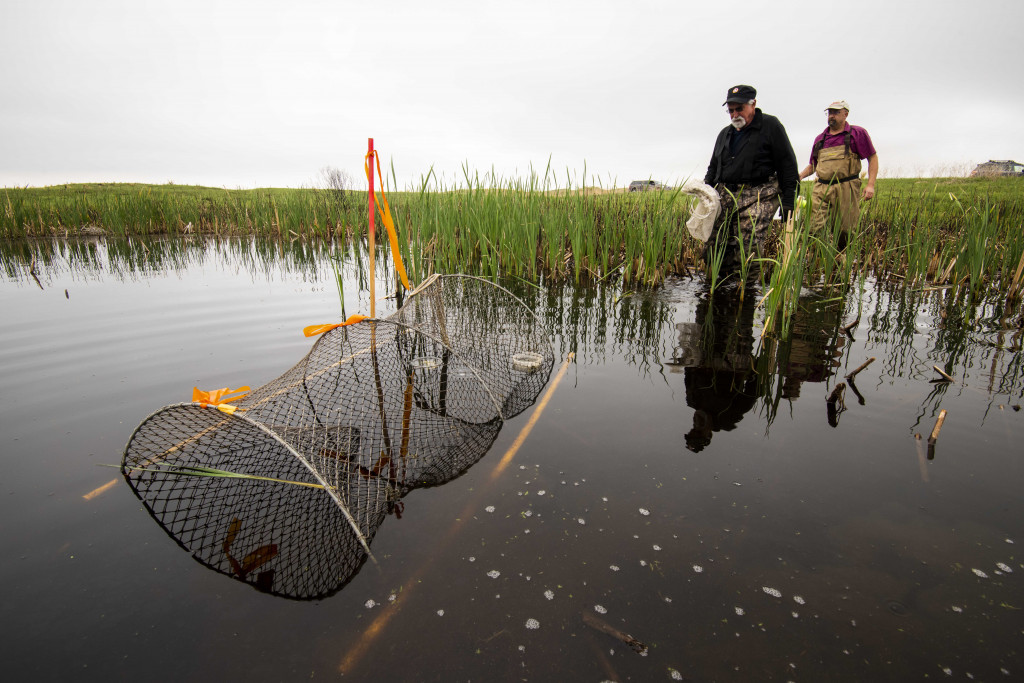
Upon his arrival to Nebraska, Lang immediately observed the remains of more than 50 dead Blanding’s turtles on the blacktop of U.S. Highway 83. Given what was known about the abundance of these turtles in Nebraska at that time, this much road mortality seemed incredible.
Lang and other researchers later learned a lot more Blanding’s turtles were in the Sandhills, and the highway mortality, while certainly undesirable, was not as much of a threat to the population as they originally suspected. By trapping turtles, marking them and tracking them with telemetry equipment, they later estimated just the refuge population at more than 130,000 turtles — about 26 times that of the one in Minnesota.
“The Sandhills total population is likely well over several hundred thousand,” Lang said.
But despite their abundance, this is a difficult turtle to study.
“They’re kind of shy,” Lang said. “They also live in habitat which is really hard to make observations on. They don’t sit out and bask as readily as painted turtles.”
Similar to other hard-shelled relatives, Blanding’s turtles move between habitats depending on the season.
In May and June, the females travel as much as 1 mile away from the marsh to each lay about a dozen eggs, and that is when they are most vulnerable to becoming roadkill. Thankfully, Sandhills roads are some of the most lightly traveled in America.
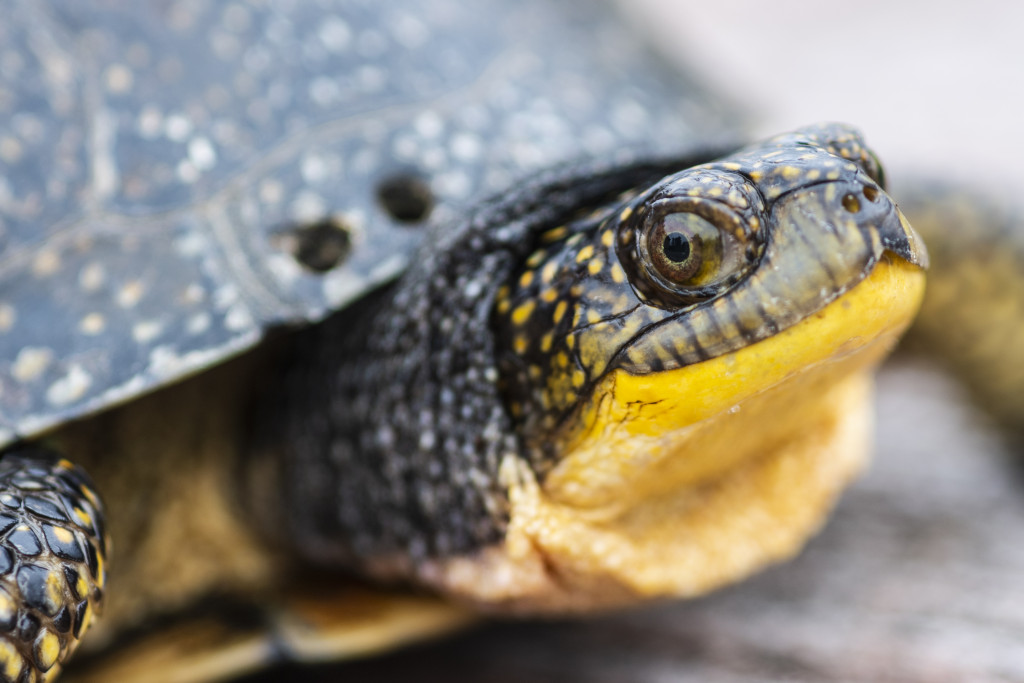
“The magic here is that the turtles are basically surrounded by almost perfect nesting substrate,” Lang said. “Sand is what they like, and so they could almost nest anywhere. It’s just a matter of picking the right slope; the right place where the sand has drained and warmed. Basically they can hike out of these lakes in almost any upland area, and it’s probably 10 times better than most Blanding’s turtles in the world would find.”
Mark Lindvall, a retired manager of the refuge and project volunteer, said Blanding’s turtles deserve special consideration in road development. They seem to be more timid than other kinds of turtles, a characteristic that he believes may make them more vulnerable to traffic than other species.
“They’re crummy at crossing the road,” he said. “Of all the turtles, they’re the worst. The car comes by and they suck in (their shell) and just stay there. Others, such as painted turtles or snappers, will suck in, but then get out of there. Blanding’s just linger.”
A couple of road projects have helped the turtles, he believes.
During the Highway 83 project, sections of chain link fence were installed along problem areas of the road, directing turtles to cross in culverts that connect the expanse of lakes and marshes.
Earlier, in 1999, Little Hay Road, which provides access to many sites on the refuge, was improved from a two-track trail to a graded gravel road.
“I think this reduced turtle mortality, as prior to the improvements turtles were less visible to motorists and less likely to linger on the road,” he said. “When it was a two-track, water collected in the ruts and attracted turtles.”
With the ruts’ puddles largely concealed by grass, drivers on two-tracks smashed turtles without even knowing it.
Nest predation also is a major threat to Blanding’s turtles. Less than 24 hours after laying her eggs, the female returns to the marsh leaving behind six to 21 buried prizes for skunks, foxes, raccoons and other nest predators. The eggs have an incubation period of 50-75 days, but are most exposed during the first 48 hours when scent is strongest. Studies have shown that Blanding’s and other turtles in their range face more than 80 percent mortality because of nest predation.
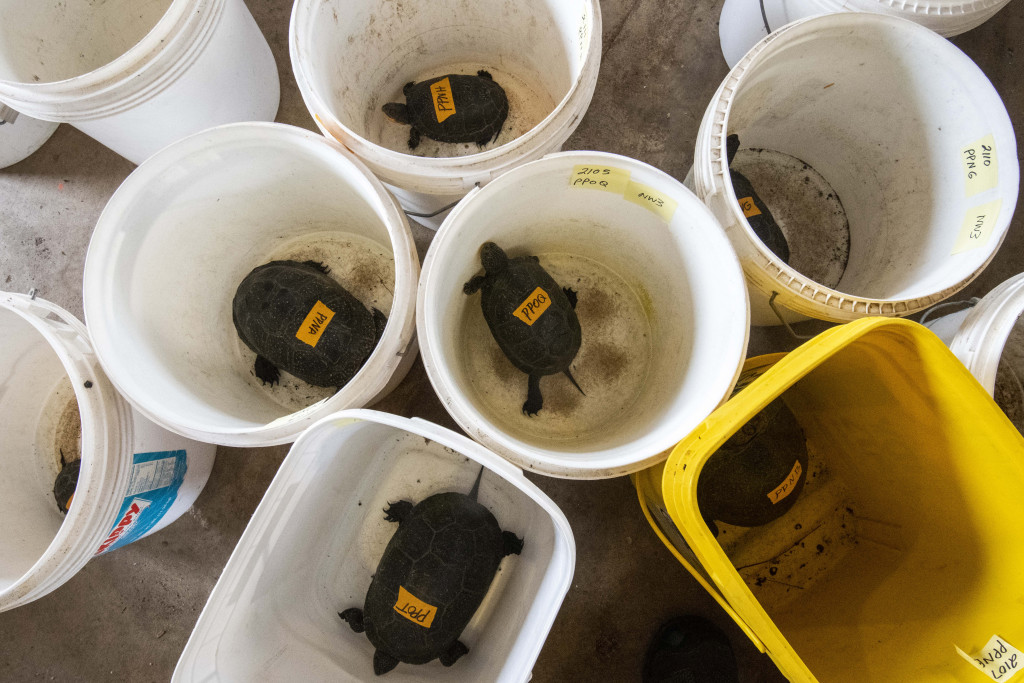
Conversion of wetlands and uplands to agricultural and other uses has been hard on the species, destroying habitat and making it easier for predators to locate nests in what remains.
“They get hammered like crazy on the East Coast, mostly crossing roads, because their habitat has been all fragmented,” Lang said.
Even though the Blanding’s turtle’s conservation status forbids it from being possessed, transported or sold in Nebraska, that does not always stop people from unlawfully picking them up. Lindvall said there have been several instances of such suspicious activity by visitors to the refuge.
The turtles are especially sought as pets overseas and are sold for hundreds of dollars, Lang said. While Lang worries that added attention could draw unlawful collectors to the Sandhills, he knows the turtles’ story needs to be told in order to protect them into the future.
“It cuts both ways,” Lang said. “If you don’t make it known that it’s important, you could lose aspects of the region that are important to the turtles.”
Return to the Refuge
When coronavirus restrictions sidelined plans for Lang to return to India to study gharial crocodiles last spring, he decided it was time to revisit the Valentine National Wildlife Refuge. He got clearance from the refuge, loaded the hoop traps — he’d been paying storage for them since the Blanding’s project ended in 2003 — and headed south on Easter weekend.
“I kept the traps because I always dreamed about coming back here,” he said, relating his goal to revisit turtles he had handled in the past.
To mark the turtles, the researchers use an alphabetic code that relates to scales on the outer edge of the carapace, the top part of the shell. Holes are drilled in specific locations to give each turtle a unique identifier. Lang is not the only one who has marked Blanding’s turtles in the Sandhills. In 1991, prior to Lang’s involvement, U.S. Fish and Wildlife Service biologist Bruce Bury marked dozens of them.
Lang set up camp, and the traps were set at lakes and marshes throughout the refuge just as they were in the early 2000s.

but also may be compared by researchers who capture the turtle in coming decades. Photo by Justin Haag.
“The main thing I was trying to do is get some idea of the age distribution of the turtles,” he said. “The hope was that we would recover the turtles that we marked and that were marked in 1991. And we did that.”
Lang and volunteers captured 285 Blanding’s turtles, and he was ecstatic to find 30 turtles with holes that he had drilled about two decades ago, and more than 10 that Bury had marked three decades ago.
“These adults are really homebodies, it looks like,” Lang said, while relating a story about capturing a 42-year-old turtle in the exact same place near Hackberry Lake that he did 20 years ago. “She’s still there. Really, what we have are these resident populations that seem to be spread all over the refuge.”
He said evidence is showing that Blanding’s turtles are not evenly dispersed throughout the refuge.
“We get turtles that are 3 years old, which are almost the smallest turtles I’ve ever seen here, all the way to the full adults that are 40 years old, and they’re all in the same trap,” he said. “Even if we have two hoop nets in one small wetland, all of the Blanding’s will be in one trap and there won’t be any Blanding’s in the other trap. So, there’s some social thing going on, too. They may be cuing each other in.”
From what he saw in 2021, Lang suspects the Sandhills population is not only super abundant and stable, but likely increasing. The Indian crocodiles are taking priority this spring, but he plans to return to the refuge to study turtles in coming years.
Beyond the Sandhills
Blanding’s turtles are doing best in the Sandhills habitat, but the species can be found in other parts of Nebraska. Thanks to another research project, we have a better understanding of where those places are and how well the population is connected.
Herpetologist Dan Fogell, a science instructor at Southeast Community College in Lincoln, conducted a presence-absence survey of the species that ended in fall 2021. The project took him to 427 sites in the Platte, Elkhorn and Loup valleys where he became proficient at looking through spotting scopes and binoculars and differentiating the heads of Blanding’s turtles from painted turtles and other species.
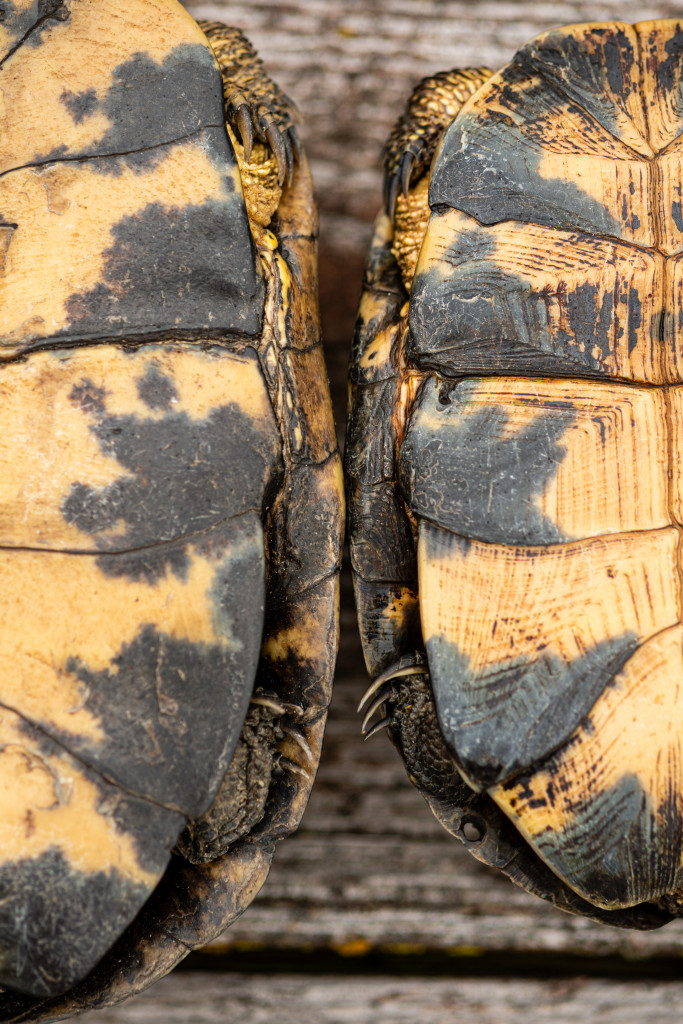
He found the distribution to be continuous along the Niobrara River between Valentine and the community of Niobrara. He also found them to be present in the Elkhorn and Loup valleys. The research confirmed that Blanding’s turtles were present at locales of many previous sightings, but he also found them residing at more than 30 new sites.
“They are conspicuously absent along the Platte River between North Platte and the confluence with the Loup River,” Fogell said. “There are a lot of places that they should be, but they aren’t there.”
He spotted the most turtles of any one location, 11, at Memphis Lake State Recreation Area between Lincoln and Omaha.
Oddly, he said, a couple of Blanding’s turtles have been reported way out west in the Chadron vicinity, and one near Fort Robinson State Park, in the past decade. Whether they arrived there naturally, or if someone moved them there, is unknown.

Tests indicated that a Blanding’s turtle found roaming near Scottsbluff in 2017 had previously been kept as a pet. It is now living at the Wildcat Hills Nature Center near Gering.
“It’s not unlikely that they could expand to the west,” Fogell said. “They’re a lot more tolerant to the changes in climate that we’re experiencing and will continue to experience. It’s expected that their numbers will increase and the distribution will expand as a result of climate change.”
If they are expanding west toward other “real estate,” it will only solidify Nebraska’s claim as Blanding’s turtle capital of the world. Let’s just hope they take roads less traveled in the process. ■
The post Turtles at Home in Nebraska appeared first on Nebraskaland Magazine.
















